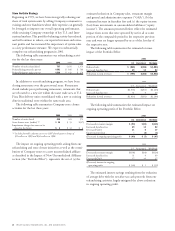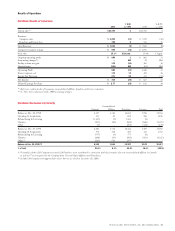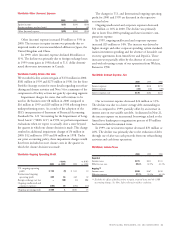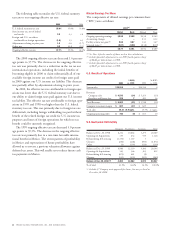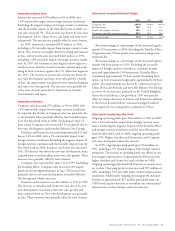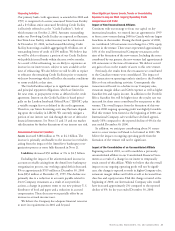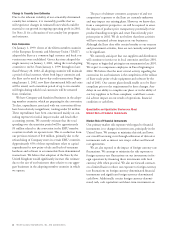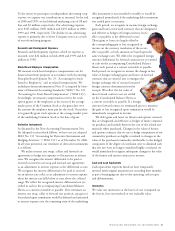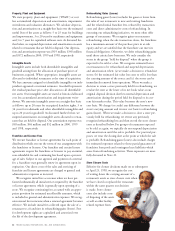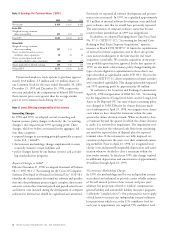Pizza Hut 2000 Annual Report Download - page 40
Download and view the complete annual report
Please find page 40 of the 2000 Pizza Hut annual report below. You can navigate through the pages in the report by either clicking on the pages listed below, or by using the keyword search tool below to find specific information within the annual report.38 TRICON GLOBAL RESTAURANTS, INC. AND SUBSIDIARIES
Change in Casualty Loss Estimates
Due to the inherent volatility of our actuarially-determined
casualty loss estimates, it is reasonably possible that we
will experience changes in estimated losses which could be
material to our growth in ongoing operating profit in 2001.
See Note 21 for a discussion of our casualty loss programs
and estimates.
Euro Conversion
On January 1, 1999, eleven of the fifteen member countries
of the European Economic and Monetary Union (“EMU”)
adopted the Euro as a common legal currency and fixed con-
version rates were established. Greece has since adopted the
single currency on January 1, 2001, taking the total adopting
countries to twelve. From January 1, 1999 through no later
than February 28, 2002, all adopting countries will maintain
a period of dual currency, where both legacy currencies and
the Euro can be used in day-to-day credit transactions. Begin-
ning January 1, 2002, new Euro-denominated bills and coins
will be issued, and a transition period of up to two months
will begin during which local currencies will be removed
from circulation.
We have Company and franchised businesses in the adopt-
ing member countries, which are preparing for the conversion.
To date, expenditures associated with our conversion efforts
have been relatively insignificant, totaling under $2 million.
These expenditures have been concentrated mainly on con-
sulting expenses for initial impact studies and head office
accounting systems. We currently estimate that the total
spending over the transition period will be approximately
$5 million related to the conversion in the EMU member
countries in which we operate stores. This is a reduction from
our previous estimate of $10 million, primarily due to the
refranchising of Company stores in certain EMU countries.
Approximately 45% of these expenditures relate to capital
expenditures for new point-of-sale and back-of-restaurant
hardware and software to accommodate Euro-denominated
transactions. We believe that adoption of the Euro by the
United Kingdom would significantly increase this estimate
due to the size of our businesses there relative to our aggre-
gate businesses in the adopting member countries in which
we operate.
The pace of ultimate consumer acceptance of and our
competitors’ responses to the Euro are currently unknown
and may impact our existing plans. However, we know that,
from a competitive perspective, we will be required to assess
the impacts of product price transparency, potentially revise
product bundling strategies and create Euro-friendly price
points prior to 2002. We do not believe that these activities
will have sustained adverse impacts on our businesses.
Although the Euro does offer certain benefits to our treasury
and procurement activities, these are not currently anticipated
to be significant.
We currently anticipate that our suppliers and distributors
will continue to invoice us in local currencies until late 2001.
We expect to begin dual pricing in our restaurants in late 2001.
We expect to compensate employees in Euros beginning in
2002. We believe that the most critical activity regarding the
conversion for our businesses is the completion of the rollout
of Euro-ready point-of-sale equipment and software by the
end of 2001. Our current plans should enable us to be Euro-
compliant prior to the requirements for these changes. Any
delays in our ability to complete our plans, or in the ability of
our key suppliers to be Euro-compliant, could have a mate-
rial adverse impact on our results of operations, financial
condition or cash flows.
Quantitative and Qualitative Disclosures About
Market Risk of Financial Instruments
Market Risk of Financial Instruments
Our primary market risk exposure with regard to financial
instruments is to changes in interest rates, principally in the
United States. We attempt to minimize this risk and lower
our overall borrowing costs through utilization of derivative
instruments such as interest rate swaps, collars and forward
rate agreements.
We are also exposed to the impact of foreign currency rate
fluctuations. We attempt to minimize the risk exposure to
foreign currency rate fluctuations on our investments in for-
eign operations by financing those investments with local
currency debt when practical. We also use forward contracts
on a limited basis to reduce our exposure to foreign currency
rate fluctuations on foreign currency denominated financial
instruments and significant foreign currency denominated
cash flows. Additionally, certain foreign currency denomi-
nated cash, cash equivalents and short-term investments are


